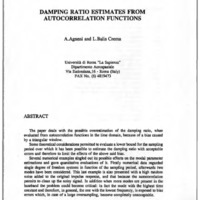-
Title
-
Damping Ratio Estimates From Autocorrelation Functions
-
Report Number
-
WL-TR-91-3078 Volume III, p. GCD-1 thru GCD-16
-
Creator
-
Agneni, A.
-
Crema, L. Balis
-
Corporate Author
-
Universita di Roma "I.a Sapienza", Dipartimento Aerospaziale
-
Date
-
1991
-
Date Issued
-
1991-08
-
Extent
-
16
-
Identifier
-
ADA241313
-
Format
-
1 online resource
-
Abstract
-
The paper deals with the possible overestimation of the damping ratio, when evaluated from autocorrelation functions in the time domain, because of a bias caused by a triangular window. Some theoretical considerations permitted to evaluate a lower bound for the sampling period over which it has been possible to estimate the damping ratio with acceptable errors and therefore to limit the effects of the above said bias. Several numerical examples singled out its possible effects on the modal parameter estimations and gave quantitative evaluations of it. Firstly numerical data regarded single degree of freedom systems in function of the sampling period, afterwards two modes have been considered. This last example is also presented with a high random noise added to the original impulse response, and that because the autocorrelation permits to clean up the noisy signal. In addition when more modes are present in the baseband the problem could become critical: in fact the mode with the highest time constant and therefore, in general, the one with the lowest frequency, is exposed to bias errors which, in case of a large oversampling, become completely unacceptable
-
Description
-
The paper deals with the possible overestimation of the damping ratio, when evaluated from autocorrelation functions in the time domain, because of a bias caused by a triangular window. Some theoretical considerations permitted to evaluate a lower bound for the sampling period over which it has been possible to estimate the damping ratio with acceptable errors and therefore to limit the effects of the above said bias. Several numerical examples singled out its possible effects on the modal parameter estimations and gave quantitative evaluations of it. Firstly numerical data regarded single degree of freedom systems in function of the sampling period, afterwards two modes have been considered. This last example is also presented with a high random noise added to the original impulse response, and that because the autocorrelation permits to clean up the noisy signal. In addition when more modes are present in the baseband the problem could become critical: in fact the mode with the highest time constant and therefore, in general, the one with the lowest frequency, is exposed to bias errors which, in case of a large oversampling, become completely unacceptable
-
Distribution Classification
-
1
-
Distribution Conflict
-
No
-
DTIC Record Exists
-
No
-
Illinois Tech Related
-
No
-
Photo Quality
-
Not needed
-
Report Availability
-
Full text available
-
Type
-
article
 aricleGCD
aricleGCD